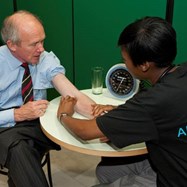University application figures 2012 cycle
09 July 2012
Commenting on the release of UCAS data on university applications for 2012 entry, Russell Group Director General Dr Wendy Piatt, said:
“These figures show once again that over the long-term the demand for higher education is actually rising. This year 618,247 prospective students have applied - more than the 592,312 who applied three years ago in 2009.
“Contrary to what some doomsayers predicted, UCAS has found that overall applications from 18-year-olds have fallen by just 2.6% point - and that is even though there are fewer 18-year-olds in the UK this year and there was a peak in applications last year as fewer people chose to take gap years.
“Prospective students know that in tough economic times a degree - especially one from a leading university - remains a smart investment. Overall applications to our universities have dropped by less than the sector average.
“In the past a fall in applications in the first year of higher fees has been followed by increases in subsequent years.
“We are especially pleased that UCAS has found that the increase in fees has not had a disproportionate impact on application rates for prospective students from more disadvantaged backgrounds.
“We have always been clear that money worries shouldn’t stop anyone from applying: there are no up-front fees, repayments are only made when they’re affordable and there is generous help with living costs. If you’re good enough to get in, you can afford to go.
“About one in three Russell Group students receive a bursary or scholarship that never has to be repaid, and our universities are spending unprecedented sums on financial support. Every student with the talent, potential and ability to succeed at a Russell Group university should apply.
“We remain concerned however that the lack of financial support at postgraduate level is another hurdle for students to overcome - especially those from more disadvantaged backgrounds. We don’t believe that fees deter poorer students when combined with loans and a progressive repayment system. But the lack of funding for postgraduates could have damaging consequences.”
Notes for editors
- Total applicants through UCAS by 30 June deadline by year:
2008
2009
2010
2011
2012
540,108
592,312
660,953
669,956
618,247 - With the introduction of English ‘top-up fees’ in 2006, applications decreased by 4.5 per cent but were followed by a 7.1 per cent increase in 2007 and a 10.1 per cent increase in 2009. (Source: UUK, variable tuition fees in England: assessing their impact on students and higher education institutions http://www.universitiesuk.ac.uk/Publications/Documents/VariableTuitionFees_FourthReport.pdf)
- By 2015-16 Russell Group universities in England plan to spend £153.7million of their additional fee income on financial support for students. This represents an average per institution of £9.6million with some of our universities spending as much as £17million. Overall, this amounts to over £5.9million more per institution than the sector average of £3.7million. This investment will be targeted so that those in most need of financial support receive the help they need.
- Research undertaken by the Centre for the Economics of Education (Chevalier, A. and Conlon, G. Does it pay to go to a prestigious university?, LSE (March 2003) has identified an average wage premium of up to 10% (9.4%) for a graduate from a Russell Group university compared to a graduate from a modern university.
-
Hamir Patel
hamir.patel@russellgroup.ac.uk
020 3816 1316
-
Hollie Chandler
Hollie.Chandler@russellgroup.ac.uk
020 3816 1307
 X
X


